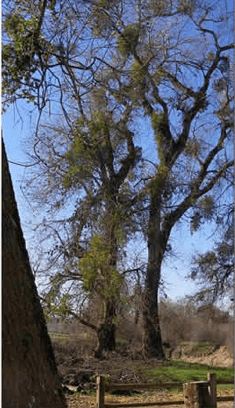 Description: Mistletoe is a PARASITIC plant that grows as a hanging bush on the branches of trees. It will grow on most deciduous trees but prefers those with soft bark. The most common trees are oak and apple. It is easy to spot in winter when the leaves have fallen because it is evergreen. It can reach 2-5 feet in diameter at maturity.
Mistletoe has small, sticky white berries that are very attractive to birds. In most cases, the initial infestation occurs at the top of larger, older trees, as that is where birds prefer to perch. A heavy buildup can occur because many berries are produced and attract lots of birds. Once the seed from the berry comes in contact with the bark, within days a threadlike root appears and will eventually pierce the bark and root itself into the growing wood. Mistletoe steals nourishment from the tree. The wood of Mistletoe has been found to have twice as much potash and five times as much phosphoric acid as the tree from which it grew.
Description: Mistletoe is a PARASITIC plant that grows as a hanging bush on the branches of trees. It will grow on most deciduous trees but prefers those with soft bark. The most common trees are oak and apple. It is easy to spot in winter when the leaves have fallen because it is evergreen. It can reach 2-5 feet in diameter at maturity.
Mistletoe has small, sticky white berries that are very attractive to birds. In most cases, the initial infestation occurs at the top of larger, older trees, as that is where birds prefer to perch. A heavy buildup can occur because many berries are produced and attract lots of birds. Once the seed from the berry comes in contact with the bark, within days a threadlike root appears and will eventually pierce the bark and root itself into the growing wood. Mistletoe steals nourishment from the tree. The wood of Mistletoe has been found to have twice as much potash and five times as much phosphoric acid as the tree from which it grew.
 Symptoms: Once the root enters the tree it goes to the water-conducting tissues. The root grows up and down within the branch. It may take years before the plant blooms and produces seeds. Older plants can develop large swollen areas on the host branches. If the visible portion of the mistletoe is removed, new plants often re-sprout.
Healthy trees can tolerate a few mistletoe branch infections, although individual branches may be weakened or killed. Trees that are heavily infested may have reduced vigor, become stunted, or can even be killed, especially if they are already under stress due to drought or disease.
Symptoms: Once the root enters the tree it goes to the water-conducting tissues. The root grows up and down within the branch. It may take years before the plant blooms and produces seeds. Older plants can develop large swollen areas on the host branches. If the visible portion of the mistletoe is removed, new plants often re-sprout.
Healthy trees can tolerate a few mistletoe branch infections, although individual branches may be weakened or killed. Trees that are heavily infested may have reduced vigor, become stunted, or can even be killed, especially if they are already under stress due to drought or disease.
 Action: Pruning out infected branches, as soon as the parasite appears, is the most effective way to control mistletoe. Infected branches need to be cut at least one foot from the point the mistletoe originated in order to remove all of the roots.
If nothing else is done, just removing the mistletoe each year is worthwhile to stop the spread of seeds. In some cases it is best to remove the tree to prevent it from being a major source of mistletoe seeds. If no action is taken mistletoe will eventually take over the tree and allow that tree to spread it to others nearby. When heavily infested death of the tree can occur.
Thank you for reviewing this information. Schneider Tree Care is committed to preserving and enhancing the quality of your property through tree care education and services. We employ professionally trained and certified arborists who are available to meet with you for a consultation at no charge. If you have any questions or need additional information regarding the health of your trees, please contact us.
Action: Pruning out infected branches, as soon as the parasite appears, is the most effective way to control mistletoe. Infected branches need to be cut at least one foot from the point the mistletoe originated in order to remove all of the roots.
If nothing else is done, just removing the mistletoe each year is worthwhile to stop the spread of seeds. In some cases it is best to remove the tree to prevent it from being a major source of mistletoe seeds. If no action is taken mistletoe will eventually take over the tree and allow that tree to spread it to others nearby. When heavily infested death of the tree can occur.
Thank you for reviewing this information. Schneider Tree Care is committed to preserving and enhancing the quality of your property through tree care education and services. We employ professionally trained and certified arborists who are available to meet with you for a consultation at no charge. If you have any questions or need additional information regarding the health of your trees, please contact us. 









